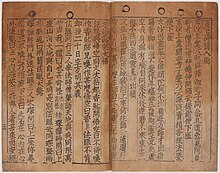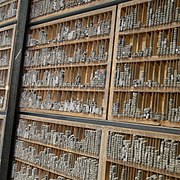East Asian typography
This articleneeds additional citations forverification.(August 2022) |
East Asian typographyis the application oftypographyto thewriting systemsused for theChinese,Japanese,Korean,andVietnameselanguages. Scripts represented in East Asian typography includeChinese characters,kana,andhangul.
History
[edit]
Typesettingwithmovable typewas invented in China during theSong dynastybyBi Sheng(990–1051). His system used ceramic materials; clay type printing continued to be practiced in China until theQing dynasty(1644–1912).Wang Zhen(1290–1333) was one of the pioneers ofwood type.Although the wooden type was more durable under the mechanical rigors of handling, repeated printing wore the character faces down and the types could be replaced only by carving new pieces.[1]
Metal movable type was first invented in Koreac. 1230during theGoryeoperiod (918–1392).Hua Sui(1439–1513) introduced bronze type printing to China in 1490. The diffusion of both movable-type systems was limited and the technology did not spread beyond East and Central Asia, however.[2]

Before the 19th century,woodblock printingwas favored over movable type to print East Asian text, because movable type required reusabletypesfor thousands ofChinese characters.[3]During the Ming dynasty,Ming typefaceswere developed with straight and angular strokes, which made them easier to carve from woodblocks than calligraphic forms such asregular script.[4]
Movable type for Chinese characters was popularized in the mid-19th century by American missionary William Gamble, who led the American Presbyterian Mission Press (APMP) inNingboandShanghaifrom 1858 to 1869. Gamble developed anelectrotypingprocess to reproduce Chinese character types. This method produced characters that were clearer and more closely resembled calligraphic glyphs, and it allowed the types to be made in smaller sizes without reducing quality.[5][6]In 1869, on his way back to the United States, Gamble stopped over in Japan, where he introduced the electrotype method toMotogi Shōzō.[7]In 1873, Motogi established Tsukiji Type Foundry, the first type foundry in Japan.[3][better source needed]Japanese type foundries inventedGothic typefacesinspired by Latinsans-seriffonts, as well as variations of the Ming typeface. Japanese typefaces influencedtype designacross China and Japan.[4]Also, the emergence of newspapers in the 19th century made movable type a worthwhile investment.[3]
Following theproclamation of the People's Republic of Chinain 1949, type designers in mainland China aimed to break free from Japanese stylistic influences by creating typefaces that looked more like handwritten Chinese.[4]Starting in the 1960s, the state-owned Shanghai Printing Technology and Research Institute (SPTRI) developed new typefaces forsimplified charactersin the four primary type families:Fangsong(or "Imitation Song" ), sans-serifGothic,Ming,andKaiti.Of thesetypeface families,the PRC government favored Gothic typefaces because they were plain and "represented a break with the past". The SPTRI was subsequently privatized in the 1990s.[7][better source needed]
Type families
[edit]Ming
[edit]
Mingtypefaces (Minchoin Japanese; also known asSongwhen used with simplified Chinese[8]) are characterized by contrasting vertical and horizontal strokes. Small triangles calleduroko(Lân'fish scales') are nestled into the stroke, and are analogous toserifsinLatin scripttype.
Gothic
[edit]
East Asian Gothic typeface,known asheiti('black form') in Chinese, are sans-serif typefaces used with East Asian scripts. They can be further divided into two main types: round sans fonts have rounded ends, while square sans fonts have square ends.[9]
Fangsong
[edit]Fangsong(or "Imitation Song" ) is a style modeled after that used inLin'anduring theSouthern Song dynasty(1127–1279). Fangsong is a class ofregular scripttypeface, and the standard used in official documents produced by the Chinese government,[10]andcivil drawingsin both China and Taiwan.
Kaiti
[edit]Kaititypefaces imitate handwritten regular script, as opposed to printed regular script.
Typographic conventions
[edit]Symbols
[edit]Japanese has a set of characteristicpunctuation marks;seeList of Japanese typographic symbolsfor more details.[11]
Instead of underlines or cursive, Chinese, Japanese and Korean useemphasis marks.
Ruby text
[edit]Ruby charactersare small, annotativeglossesthat are usually placed above or to the right of Chinese characters to indicate their pronunciation.
See also
[edit]- List of CJK fonts
- Han unification– work to allocate Unicode code points to CJK characters, identifying any that are only stylistically different.
- Horizontal and vertical writing in East Asian scripts
-
A 1921 advertisement inThe Asahi Shimbun
-
A frame ofsortsfor traditional Chinese script
References
[edit]Citations
[edit]- ^Tsien & Needham (1985),pp. 201–217.
- ^Ch'on (1993),p. 19.
- ^abcRigaud, Émilie (2 March 2022),"Japanese Typography: Wood to Metal to Light to Vectors",Pangram Pangram Foundry,retrieved29 August2022
- ^abcLiu (2022).
- ^Norman, Jeremy M. (23 February 2023),"Missionary Printer William Gamble Introduces Electrotyping to Chinese Printing Type Production",HistoryofInformation.com,retrieved10 March2023
- ^"Biographical Index of Missionaries — China",Presbyterian Heritage Center,2015,retrieved10 March2023
- ^abNg, Brian (6 September 2021),"Revolutionary type: Meet the designer decolonizing Chinese fonts",Rest of World,retrieved17 September2022
- ^Lunde (2008),pp. 23–25.
- ^"Understanding Japanese Typography",Humble Bunny,22 August 2011,retrieved29 August2022
- ^Đảng chính cơ quan công văn cách thức GB/T 9704—2012(PDF)(in Chinese) – via Shanghai Jiao Tong University
- ^Nhật bổn ngữ tư nguyên,nihongoresources.com(in Japanese),retrieved29 August2022
Works cited
[edit]- Liu, Yuli (27 October 2022),"Deciphering the Hanzisphere",Sixth Tone,translated by Tse, Katherine,retrieved10 March2023
- Tsien, Tsuen-Hsuin;Needham, Joseph, eds. (1985),Paper and Printing,Science and Civilization in China, vol. V:1, Cambridge University Press,ISBN978-0-521-08690-5
- Ch'on, Hye-bong (1993), "Typography in Korea",Koreana,vol. 7, no. 2, pp. 10–19
- Lunde, Ken(2008),CJKV Information Processing(2nd ed.), O'Reilly,ISBN978-0-596-51447-1
External links
[edit]- Chinese Type Archive,anopen databaseof Chinese typographical concepts and typefaces



